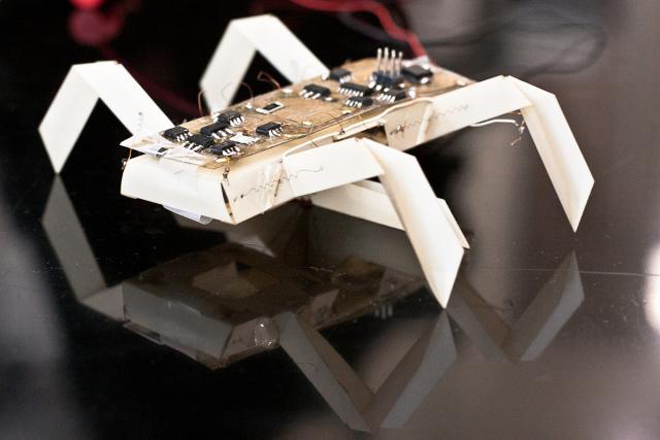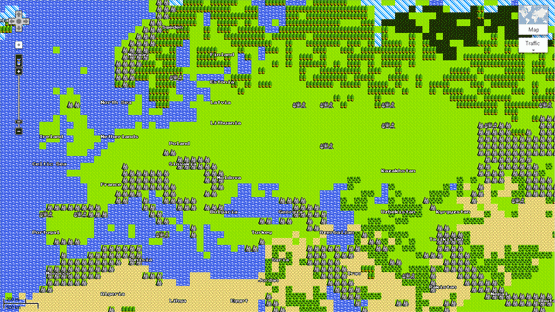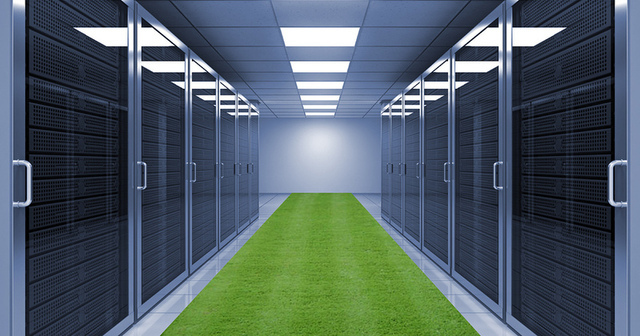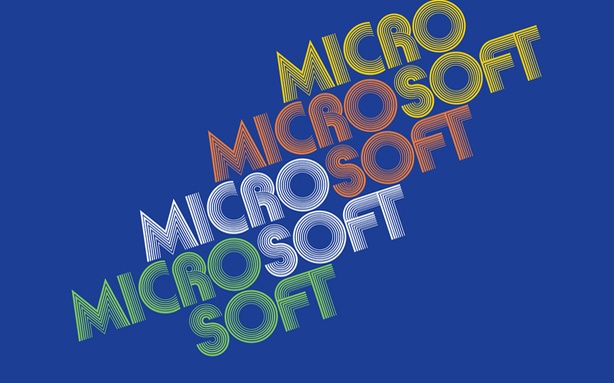Friday, April 06. 2012
Via Vanity Fair
---
When the Internet was created, decades ago, one thing was inevitable:
the war today over how (or whether) to control it, and who should have
that power. Battle lines have been drawn between repressive regimes and
Western democracies, corporations and customers, hackers and law
enforcement. Looking toward a year-end negotiation in Dubai, where 193
nations will gather to revise a U.N. treaty concerning the Internet,
Michael Joseph Gross lays out the stakes in a conflict that could split
the virtual world as we know it.
Access to the full article @Vanity Fair
Thursday, April 05. 2012
Via Wired
-----

Insect printable robot. Photo: Jason Dorfman, CSAIL/MIT
Printers can make mugs, chocolate and even blood vessels. Now, MIT scientists want to add robo-assistants to the list of printable goodies.
Today, MIT announced a new project, “An Expedition in Computing
Printable Programmable Machines,” that aims to give everyone a chance to
have his or her own robot.
Need help peering into that unreasonably hard-to-reach cabinet, or
wiping down your grimy 15th-story windows? Walk on over to robo-Kinko’s
to print, and within 24 hours you could have a fully programmed working origami bot doing your dirty work.
“No system exists today that will take, as specification, your
functional needs and will produce a machine capable of fulfilling that
need,” MIT robotics engineer and project manager Daniela Rus said.
Unfortunately, the very earliest you’d be able to get your hands on
an almost-instant robot might be 2017. The MIT scientists, along with
collaborators at Harvard University and the University of Pennsylvania,
received a $10 million grant from the National Science Foundation for
the 5-year project. Right now, it’s at very early stages of development.
So far, the team has prototyped two mechanical helpers: an
insect-like robot and a gripper. The 6-legged tick-like printable robot
could be used to check your basement for gas leaks or to play with your
cat, Rus says. And the gripper claw, which picks up objects, might be
helpful in manufacturing, or for people with disabilities, she says.

Printable gripper. Photo: Jason Dorfman, CSAIL/MIT
The two prototypes cost about $100 and took about 70 minutes to
build. The real cost to customers will depend on the robot’s
specifications, its capabilities and the types of parts that are
required for it to work.
The researchers want to create a one-size-fits-most platform to
circumvent the high costs and special hardware and software often
associated with robots. If their project works out, you could go to a
local robo-printer, pick a design from a catalog and customize a robot
according to your needs. Perhaps down the line you could even order-in
your designer bot through an app.
Their approach to machine building could “democratize access to
robots,” Rus said. She envisions producing devices that could detect
toxic chemicals, aid science education in schools, and help around the
house.
Although bringing robots to the masses sounds like a great idea (a
sniffing bot to find lost socks would come in handy), there are still
several potential roadblocks to consider — for example, how users,
especially novice ones, will interact with the printable robots.
“Maybe this novice user will issue a command that will break the
device, and we would like to develop programming environments that have
the capability of catching these bad commands,” Rus said.
As it stands now, a robot would come pre-programmed to perform a set
of tasks, but if a user wanted more advanced actions, he or she could
build up those actions using the bot’s basic capabilities. That advanced
set of commands could be programmed in a computer and beamed wirelessly
to the robot. And as voice parsing systems get better, Rus thinks you
might be able to simply tell your robot to do your bidding.
Durability is another issue. Would these robots be single-use only?
If so, trekking to robo-Kinko’s every time you needed a bot to look
behind the fridge might get old. These are all considerations the
scientists will be grappling with in the lab. They’ll have at least five
years to tease out some solutions.
In the meantime, it’s worth noting that other other groups are also building robots using printers. German engineers printed a white robotic spider last year. The arachnoid carried a camera and equipment to assess chemical spills.
And at Drexel University, paleontologist Kenneth Lacovara and mechanical engineer James Tangorra are trying to create a robotic dinosaur from dino-bone replicas.
The 3-D-printed bones are scaled versions of laser-scanned fossils. By
the end of 2012, Lacovara and Tangorra hope to have a fully mobile
robotic dinosaur, which they want to use to study how dinosaurs, like
large sauropods, moved.
Lancovara thinks the MIT project is an exciting and promising one:
“If it’s a plug-and-play system, then it’s feasible,” he said. But
“obviously, it [also] depends on the complexity of the robot.” He’s seen
complex machines with working gears printed in one piece, he says.
Right now, the MIT researchers are developing an API that would
facilitate custom robot design and writing algorithms for the assembly
process and operations.
If their project works out, we could all have a bot to call our own in a few years. Who said print was dead?
Wednesday, April 04. 2012
Via Christian Babski
-----
8 bits edition of Google maps. We are all stars now in the game show.



Tuesday, April 03. 2012
Via ars technica
-----

It's nice to imagine the cloud as an idyllic server room—with faux
grass, no less!—but there's actually far more going on than you'd think.
Maybe you're a Dropbox devotee. Or perhaps you really like streaming Sherlock on Netflix. For that, you can thank the cloud.
In fact, it's safe to say that Amazon Web Services (AWS)
has become synonymous with cloud computing; it's the platform on which
some of the Internet's most popular sites and services are built. But
just as cloud computing is used as a simplistic catchall term for a
variety of online services, the same can be said for AWS—there's a lot
more going on behind the scenes than you might think.
If you've ever wanted to drop terms like EC2 and S3 into casual
conversation (and really, who doesn't?) we're going to demystify the
most important parts of AWS and show you how Amazon's cloud really
works.
Elastic Cloud Compute (EC2)
Think of EC2 as the computational brain behind an online application
or service. EC2 is made up of myriad instances, which is really just
Amazon's way of saying virtual machines. Each server can run multiple
instances at a time, in either Linux or Windows configurations, and
developers can harness multiple instances—hundreds, even thousands—to
handle computational tasks of varying degrees. This is what the elastic
in Elastic Cloud Compute refers to; EC2 will scale based on a user's
unique needs.
Instances can be configured as either Windows machines, or with
various flavors of Linux. Again, each instance comes in different sizes,
depending on a developer's needs. Micro instances, for example, only
come with 613 MB of RAM, while Extra Large instances can go up to 15GB.
There are also other configurations for various CPU or GPU processing
needs.
Finally, EC2 instances can be deployed across multiple regions—which
is really just a fancy way of referring to the geographic location of
Amazon's data centers. Multiple instances can be deployed within the
same region (on separate blocks of infrastructure called availability
zones, such as US East-1, US East-2, etc.), or across more than one
region if increased redundancy and reduced latency is desired
Elastic Load Balance (ELB)
Another reason why a developer might deploy EC2 instances across
multiple availability zones and regions is for the purpose of load
balancing. Netflix, for example,
uses a number of EC2 instances across multiple geographic location. If
there was a problem with Amazon's US East center, for example, users
would hopefully be able to connect to Netflix via the service's US West
instances instead.
But what if there is no problem, and a higher number of users are
connecting via instances on the East Coast than on the West? Or what if
something goes wrong with a particular instance in a given availability
zone? Amazon's Elastic Load Balance allows developers to create multiple
EC2 instances and set rules that allow traffic to be distributed
between them. That way, no one instance is needlessly burdened while
others idle—and when combined with the ability for EC2 to scale, more
instances can also be added for balance where required.
Elastic Block Storage (EBS)
Think of EBS as a hard drive in your computer—it's where an EC2
instance stores persistent files and applications that can be accessed
again over time. An EBS volume can only be attached to one EC2 instance
at a time, but multiple volumes can be attached to the same instance. An
EBS volume can range from 1GB to 1TB in size, but must be located in
the same availability zone as the instance you'd like to attach to.
Because EC2 instances by default don't include a great deal of local
storage, it's possible to boot from an EBS volume instead. That way,
when you shut down an EC2 instance and want to re-launch it at a later
date, it's not just files and application data that persist, but the
operating system itself.
Simple Storage Service (S3)
Unlike EBS volumes, which are used to store operating system and
application data for use with an EC2 instance, Amazon's Simple Storage
Service is where publicly facing data is usually stored instead. In
other words, when you upload a new profile picture to Twitter, it's not
being stored on an EBS volume, but with S3.
S3 is often used for static content, such as videos, images or music,
though virtually anything can be uploaded and stored. Files uploaded to
S3 are referred to as objects, which are then stored in buckets. As
with EC2, S3 storage is scalable, which means that the only limit on
storage is the amount of money you have to pay for it.
Buckets are also stored in regions, and within that region “are redundantly stored on multiple devices across multiple facilities.”
However, this can cause latency issues if a user in Europe is trying to
access files stored in a bucket within the US West region, for example.
As a result, Amazon also offers a service called CloudFront, which
allows objects to be mirrored across other regions.
While these are the core features that make up Amazon Web Services,
this is far from a comprehensive list. For example, on the AWS landing
page alone, you'll find things such as DynamoDB, Route53, Elastic
Beanstalk, and other features that would take much longer to detail
here.
However, if you've ever been confused about how the basics of AWS
work—specifically, how computational data and storage is provisioned and
scaled—we hope this gives you a better sense of how Amazon's brand of
cloud works.
Correction: Initially, we confused regions in AWS with
availability zones. As Mhj.work explains in the comments of this
article, "availability Zones are actually "discrete" blocks of
infrastructure ... at a single geographical location, whereas the
geographical units are called Regions. So for example, EU-West is the
Region, whilst EU-West-1, EU-West-2, and EU-West-3 are Availability
Zones in that Region." We have updated the text to make this point
clearer.
Monday, April 02. 2012
Via The Atlantic Wire
-----

flickr/Jeff Dlouhy
While Apple and Google are busy getting bad press for their privacy
issues, labor practices and general big-evil-company wrongdoings,
Microsoft has done some brand regeneration, making it look like the
hippest tech company on the block these days. As Apple and Google
captured a younger, cooler demographic, the Windows maker, with its
stodgy business oriented PC-compatible operating system and notoriously
annoying browser, became synonymous with lameness. Remember all those
highly effective Mac versus PC commercials?
That PC dork (writer-performer John Hodgman) represented all things
Microsoft: Slow, uptight, badly dressed. But as Apple and Google have
grown up, they've lost their hip sheen. And, Microsoft's taking
advantage. In this era of awesomely bad, it doesn't look so lame anymore
-- especially in comparison to the other guys.
We noticed this new-found hipness when we came across the endearing Browser You Love(d) to Hate
campaign. With some admirable self-awareness, Microsoft used its own
bad reputation to argue that its hated Internet Explorer browser is on
the verge of a comeback. Layering on the hipster-irony, Microsoft
compares itself to once-passe things like PBR and mustaches, suggesting
it's just another brand that's so bad, it's cool again. It also doesn't
hurt that the overall look of the site matches that aesthetic. The Atlantic's own mustachio-ed tech man, Alexis Madrigal gave it his approval, calling this accompanying ad "definitely the funniest commercial Microsoft's ever put out." We agreed, finding the whole thing convincing enough to give our abandoned IE9 a try again. (We still prefer Chrome, by the way.)
But this image comeback isn't limited to IE. Over the last few days we've seen Hotmail ads running on Boing Boing and Jezebel,
two blogs that are hip for different reasons. Boing Boing catering to
the hippest of Internet lovers and Jezebel reaches a more mainstream but
still cool millennial audience. And in general, the overall
Microsoft-related press has been kind of good. Windows 8 surprised and excited
the tech blogger world, something a Windows browser hasn't done since
Windows 95. The company has some other exciting things going on inside
its labs. The other day, It did some Internet good with its Digital Crimes Unit. And, has even designed itself a decent looking logo. Apple's (maybe) new logo, on the other hand, with its rainbow mish-mash, feels dated.
Which brings us to the other aspect of Microsoft's renaissance: good
timing. The once-hipper than Microsoft foes, Google and Apple haven't
looked so good these days. Google, the once beloved search company, has
users uneasy with its Google+ integration, privacy issues and anti-trust concerns. Even Googlers aren't too sure
of Google's mission, these days. Appl still produces insane-popular
gadgets, but no longer wows reviewers like it once did. The new iPad is
still the best tablet out there, but it's not a must-have. Plus, it too
has gotten itself into its own privacy messes. It also had the misfortune of acting as the face of the last few months of Foxconn scandal.
Though the Foxconn protesters that threatened mass suicide back in
January made Microsoft's XBox, thanks to Mike Daisey and Apple's
financial successes, Apple not Microsoft absorbed most of the bad PR.
Part of this has to do with maturity, we suppose. An early bloomer,
Microsoft's already went through its tech company growing pains. It used
to be the evil one, remember? The one accused of monopolistic practices, of buying up the competition, of stifling innovation. But
it's no longer the bully. Google and Apple's misdeeds have
overshadowed the once dominant tech company, and while the other big
players make public messes out of themselves, Microsoft looks to be
cleaning up its image. And, we have to say, it looks good.
|







